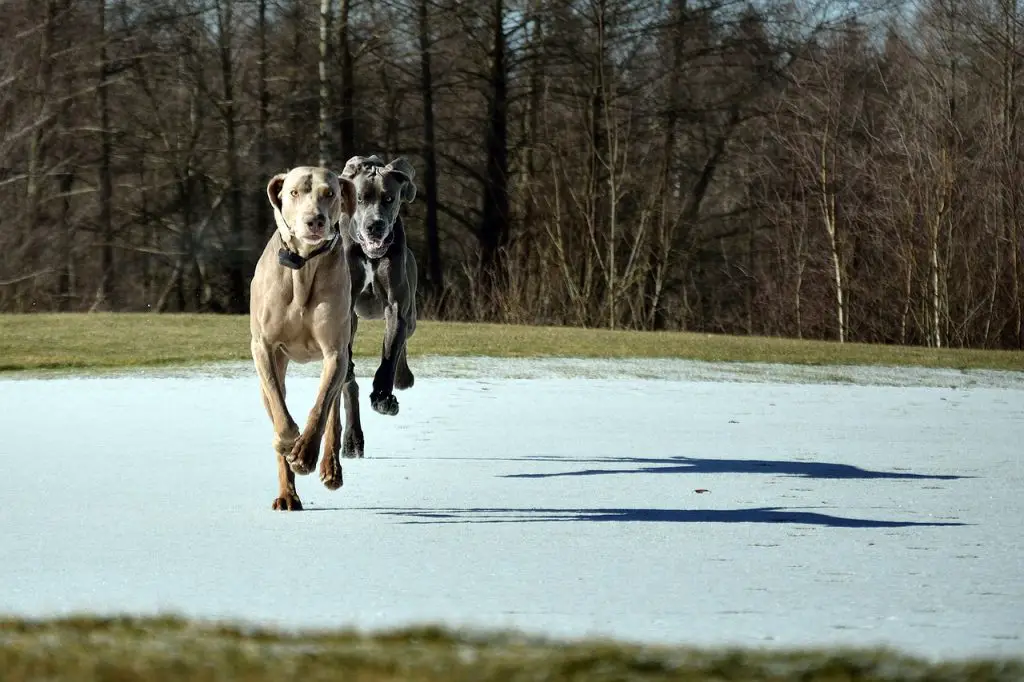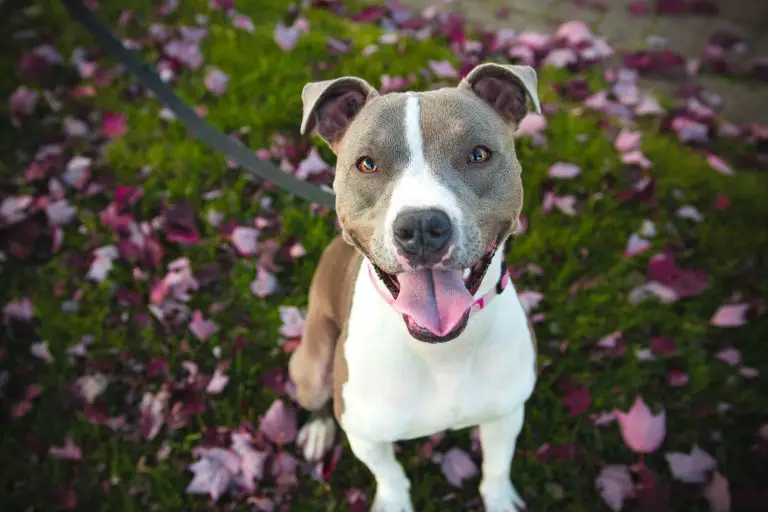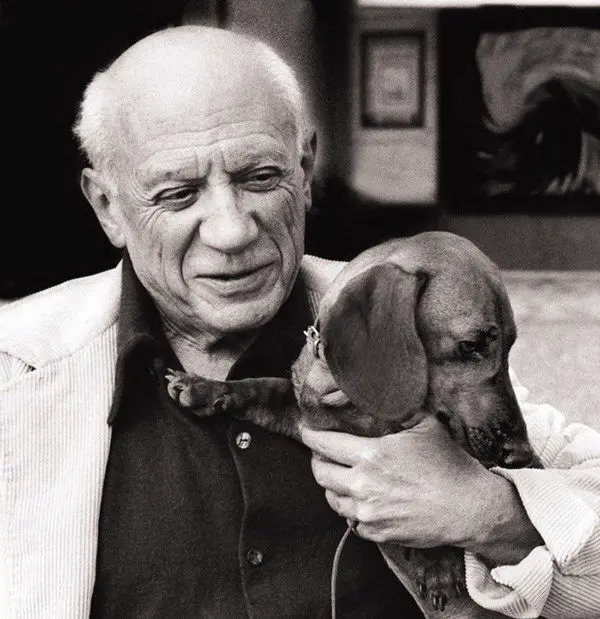So, how fast can a Great Dane run? Well, at a top speed of 30 mph, Great Danes are one of the fastest dogs that you can find.
One reason why Great Danes are so fast is that they can their large size allows them to cover a lot of ground in very little time.
The Great Dane breed came into existence by crossing the Irish wolfhound with the mastiff. Both mastiffs and Irish wolfhounds are tall dog breeds. By crossbreeding these two species, the Great Dane has been able to inherit some excellent anatomical characteristics. Mastiffs and Irish wolfhounds have a great mix of speed, agility, and size, which are now the key traits of the Great Dane.
Great Danes are so fast that they are used for hunting wild deer and boars. Sometimes, Great Danes are also deployed to hunt bears. It is clear that besides possessing great size, speed, and alacrity, Great Danes are also not lacking in strength.
Bear in mind that Great Danes are not particularly quick when they are very young. Great Danes can grow at a remarkable rate. So, while exercising these dogs, you must ensure that their growing bones do not have to bear excessive stress, which can prove detrimental. When you are training Great Danes while they are growing, make sure that you don’t subject their frame to too much stress.
Although it may not be the fastest, Great Danes rank high on the list of the fastest big dogs.
The fastest, of course, is the greyhound, which can outrace any other dog with its blistering speed of 45 miles per hour. The greyhound is a full 50 percent faster than Great Danes. Watch the video below on a Great Dane running 30 mph.

Why Are Great Danes so Fast?
- Why Are Great Danes so Fast?
- How Great Danes Got to Be so Fast?
- How to Train Great Danes for Running Long Distances?
- How to Train Great Dane Puppies to Run Fast?
- When Should You Start Training a Great Dane to Run Fast?
- What Should You Feed Great Danes While Training Them to Run Fast?
- Final Thoughts on How Fast Can a Great Dane Run
If you were to look at the anatomy of Great Danes to find clues as to why it is so fast, you would find that it is not different compared to other dog breeds.
However, there is one key variation. Despite being very slender, the dog also has legs that are quite long for its size. The slim thin frame and long legs combine to give a fast hunting dog.
Since Great Danes are so tall, their legs are remarkably long. It is the length of their legs that allow them to cover a lot of ground in a short duration. This fact is important to note while considering the dog’s speed since the Great Dane does not have significantly better running abilities than most other dogs.
Size does matter, and this is particularly true in the case of the Great Dane.
If you see the movement of the Great Dane in slow motion, you will see that it resembles a galloping horse while running. The great size, height, and speed of Great Danes make them excellent hunting dogs.
No matter what kind of dog you are looking at, in general, you will find that their anatomical design is for plenty of movement and exercise. Great Danes are no different in this regard.
Other dogs happen to be slower because they have shorter legs despite an agile-looking and robust body. This, of course, does not apply to Great Danes.
Since Great Danes are strong and quick, they have been prized as hunting dogs for hundreds of years.
How Great Danes Got to Be so Fast?
The roots of the Great Dane can be traced back to Germany and Austria, where the Suliot dog, the Molossian hound, and other dog breeds from Greece were bred to increase the height of the boarhound.
Although agile and fast, the boarhound wasn’t tall enough for the liking of hunters at that time. So the boarhound was mixed with other breeds to give a dog of great height, which we recognize today as the Great Dane. These canines are so tall that some of the tallest living dogs are more often than not Great Danes.
During the sixteenth century in England, Irish wolfhounds and English mastiffs were crossbred to give long-legged and robust dogs. These were popular not just in England but also had high demand all over Europe. The nobility of Europe preferred these able-bodied dogs in their hunting expeditions.
Bear in mind that the Irish Wolfhounds and the English Mastiffs were hybrid breeds of different sizes and not formal breeds. These dogs came to be known as the Englische Tocke or the Englische Docke. Hence, they had a completely different name from what we use today. This animal later came to be called a dogge. In Germany, it was referred to as the ‘Englischer Hund’ or the ‘English Dog.’
Since the start of the seventeenth century, these dogs were bred and reared in the princely courts of Germany and other European countries for hunting purposes.
The nobility favored these capable dogs for hunting deer, boars, and even bears. Their owners were so enamored with these dogs that they would also let them into their bedchamber during evenings.
Hence, the dog became known as the Kammerhunde or the chamber dog. Besides simply endearment, these useful dogs served another key purpose. They proved to be loyal and fearless companions that princes and nobility could keep to protect themselves against assassins.
Before the invention of firearms, the Englische Dogge was deployed during hunting to catch hold of a boar or bear. Additionally, the Englische Dogge would keep the prey in place till the hunters moved in for the kill.
However, following the invention and the proliferation of firearms, this custom soon ceased, and with it went down the popularity of the Englische Dogge and other hunting dogs. This breed was then kept as a pet for hobby or luxury.
The Great Dane came into being when a Berlin committee in 1878 changed the name of the Englische Dogge to the Deutsche Dogge, which became the primary breed from which the Great Dane was derived.
Consequently, during the 19th century, in several English speaking countries, the dog came to be called the ‘German boarhound.’ German breeders marketed this breed as the ‘German Mastiff’ or the ‘German Dogge’ to give it a touch of foreign luxury so that this dog could be differentiated from other common working dogs.
However, the name of the breed converted to the Great Dane since public sentiment was turning against Germany at that point.
Despite the advent of firearms, Great Danes are still used by avid hunters to hunt down wild boars. Of course, there is not just one Great Dane involved. There is an entire pack of Great Danes that accompany hunters on such expeditions.
You can see videos uploaded YouTube where huntsmen show their hunting adventures with Great Danes at the very helm. You can see how fast these creatures move and how good they are at holding down their prey until the master arrives to finish them off. There used to be a time when masters would ride horses, but now it appears that the quad bike is their transport mode of choice.
Since they have been the hunting dogs of choice over the past few hundred years, you may want to take a few of these dogs on your next hunting trip – if you are a hunting enthusiast.
For such purposes, speed is just one of the many attributes required for hunting dogs. Strength and stamina are the other two qualities that are necessary. Fortunately, Great Danes can build up and abundance of strength and endurance with the right training.
The musculature and anatomical structure of Great Danes are such that they are great for running long distances. This is in addition to being pretty fast, as you already know by now.
The good news is that you can train your Great Danes to improve both their speed and stamina so that they make genuinely excellent hunting dogs.

How to Train Great Danes for Running Long Distances?
With the right training techniques, you can condition your Great Dane to chase prey over long distances. You can do this with the right diet plan and a consistent training schedule.
To improve our physical capabilities, we have to train our bodies consistently. Dogs are no different in this regard. As a trainer, you need to be patient and work hard along with your Great Danes to improve their running capabilities. With time, your forbearance will bear fruit, and you will find yourself the proud owner of Great Danes with superb running prowess.
However, before you start training your Great Danes, you must check for the following.
Be sure that your Great Dane is in good condition for training. The dog should not be sick or suffering from some severe health conditions.
You should take your Great Dane to the vet and get their advice. Learn for how long you should train them and for how long they can run with optimal training.
If your Great Dane is not used to running long distances, then start with short distances. Just in the same way as you will not run a full marathon without full training, you should also give your dog time before it is ready for long distances.
Prepare an exercise plan for your Great Dane. With proper planning, you can formulate a training schedule that will not be too hard on your Great Dane. You can improve the stamina of your Great Dane slowly using this plan, and you will not have to worry that it will wear down your dog.
After you have made your preparations for training, you can take the following steps.
- You should ensure that your Great Dane gradually transitions to longer distances
- If your Great Dane is not used to running, then you can start by walking with it over long distances
- Make sure that you have water ready by your side so that your Great Dane can avoid getting dehydrated.
- There should also be rest days to allow your Great Dane to rest and recover
- Keep a close watch on your Great Danes to be sure that you are not pushing them too hard
As for the diet plan, you can consult with your vet for optimal nutrition. You must ensure that your Great Dane is benefiting from the best possible diet to see steady progress in training.
The age of your Great Dane is going to be crucial for training them to run long distances. Your best bet is a growing pup. However, you can gradually see improvements even in older animals.
How to Train Great Dane Puppies to Run Fast?
By nature, Great Danes are very loving and protective. However, they can rather obdurate while training, so you will have to patient and firm in your resolve.
A younger pup will be more obedient as compared to an older dog.
As the old saying goes, ‘you can’t teach an old dog new tricks.’ But do bear in mind that it is not impossible to train older Great Danes. It’s just that training them is a touch harder since they tend to be strong-willed.
While training your Great Dane, you must ensure that you are consistent in your schedule and that you reward your dog amply for compliance. While training your dog, you should ensure that you are clear about what you require.
Pay close attention to the tone of your voice and make sure you sound firm but not harsh. Be patient throughout the training. While training an older animal, keep in mind that you will have to work harder so that it complies with your commands. You might need more time to train it, but the results will show sooner rather than later.
When Should You Start Training a Great Dane to Run Fast?
Training a Great Dane is a daunting task and by no means a cinch. It would be tempting to get started with training your Great Dane pups right away, but there are certain things that you must consider.
While training, your pups try to keep it fun and leisurely rather than strenuous. Remember that puppies are young and therefore not as strong as you would like them to be. So although they can’t build up stamina immediately to run for miles, you can focus on making them energetic, active, and fond of physical activity.
It would be a good idea to focus on long walks with your pups so that they can build up stamina and a preference for the outdoors as well.
You can start proper physical training once your Great Dane pup reaches the two-year mark. This might seem like a long wait and, without a doubt, it is true.
You will have to delay training because substantial physical activity can weaken the fragile bones of your pup, which are already susceptible as they are growing fast. Great Danes tend to have longer and thinner bones in their limbs compared to other smaller breeds, and hence their bones are fragile owing to their unique anatomy.
Of course, besides physical training, you can train your pup to do other things like teaching them how to sit down on command, roll over and fetch a ball. You can get started on teaching the pup these tricks right away.
You should know that all dogs have unique personalities, physical conditions, and traits. Therefore, you can start training your Great Dane pup slightly earlier than two years if it has developed good health and strength during this period.
It would be best to consult your vet to take their opinion about the best time to train your Great Dane pup. Your vet may checkup the puppy and recommend when to start teaching it and for how long.
What Should You Feed Great Danes While Training Them to Run Fast?
As with other larger breeds, Great Danes have a slow metabolism. However, since the pups proliferate in no small size, you should be confident that you are feeding them enough for their weight and height.
You can get some supplements for your Great Dane to ensure that they are getting all the minerals and vitamins that they need for healthy and rapid development.
Make sure that you take your Great Dane to the vet on schedule to be sure that they are not nutritionally deficient. Your dog may have different needs based on its particular physical condition and health.
Since Great Danes have a slower metabolism, you will have to feed them leaner meat since high fat may slow down their metabolism even more.
Final Thoughts on How Fast Can a Great Dane Run
If you were wondering about how fast can a Great Dane run, you now have a better idea. Use the steps mentioned above so that it can run fast over long distances.








